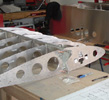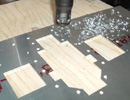


random user submitted photo
Fuel line fittings
23 posts
• Page 3 of 3 • 1, 2, 3
Re: Fuel line fittings
There is so little plumbing in this plane that cost should not even be a factor, only quality. It’s homebuilding, so quality is in the eye of the individual builder.
Skippy, we all appreciate your opinions on things, but if you want to argue then it would be more helpful if you provide specific facts and details instead of unprovable generalities. And tell us specifically what this electricians thing is???
I personally would prefer to see this discussion return to the technical advantages and alternative methods, and particularly a discussion of the safety durability and operational characteristics of different systems.
Build on. We’re all friends here. Gordon
Skippy, we all appreciate your opinions on things, but if you want to argue then it would be more helpful if you provide specific facts and details instead of unprovable generalities. And tell us specifically what this electricians thing is???
I personally would prefer to see this discussion return to the technical advantages and alternative methods, and particularly a discussion of the safety durability and operational characteristics of different systems.
Build on. We’re all friends here. Gordon
Waiex 158 New York. N88YX registered.
3.0 Liter Corvair built, run, and installed.
Garmin panel, Shorai LiFePo batteries.
3.0 Liter Corvair built, run, and installed.
Garmin panel, Shorai LiFePo batteries.
- GordonTurner
- Posts: 646
- Joined: Tue Feb 21, 2012 1:14 am
- Location: NY, NY
Re: Fuel line fittings
GordonTurner wrote:There is so little plumbing in this plane that cost should not even be a factor, only quality. It’s homebuilding, so quality is in the eye of the individual builder.
Hi Gordon,
The quantity of plumping will vary between Sonexs - eg my one has wing tanks, associated breather, fuel transfer lines and because its Rotax powered, has both boost pump line & return fuel line - many meters of fuel line.
Cost should always be a factor as long as safety is not compromised. I for one do not wish to spend any more than is necessary to achieve an efficient/safe/airworthy aircraft.
I agree with your sentiment on home building - it is a wonderful opportunity/challenge/achievement to build & fly your own aircraft - my commentary is just to inform not dictate. In my view, building an experimental is an opportunity to at least consider non aviation materials but only if there is good evidence to show that functional safety is not being compromised.
Skippy, we all appreciate your opinions on things, but if you want to argue then it would be more helpful if you provide specific facts and details instead of unprovable generalities. And tell us specifically what this electricians thing is???
Actually I did specify - where I come from they are called Electrical Glands - Google that and you will get a host of variants/sizes. They are made to facilitate the penetration, by cables or conduit, of a thin wall (most often metal) so are eminently suited to hose or pipe..
I personally would prefer to see this discussion return to the technical advantages and alternative methods, and particularly a discussion of the safety durability and operational characteristics of different systems.
From my perspective the technical attributes of "rubber" hose are:Single run - in most instances a single hose can be employed between delivery & receival points. Metal hoses often require several joins in a run (eg penetration of a fire wall)
Reduced fittings minimises potential failure/leak points.
Ease of installation, no bending, no flaring, just push on.
When correctly installed, there is no concerns of fretting/resonance/gross movement damage.
No corrosion potential internally or externally.
Cost- considerably cheaper per unit, than aluminium pipe.
Deterioration due to aging (mainly exposure to fuel) is a concern, hence the Rotax advise to replace all rubber components, exposed to fuel, every 5 years.
In my limited experience, I have found good quality rubber hose (I use Gates products) to be easy/fast to install, leak proof when the correct ID hose is specified for the OD of the spigot. The old hose (5 year replacement) is still good enough to be recycled for use on mowers/tractors/etc.
I use the latest automotive style spigot usually with just the one raised safety collar and fuel injection style hose clamps that give 360 degree even pressure. Clamps are for security, not for leak prevention, so should never be tightened such that they cause distortion or pinching of the hose.
Build on. We’re all friends here. Gordon
- Skippydiesel
- Posts: 633
- Joined: Tue Jul 06, 2021 6:24 am
Re: Fuel line fittings
Came up with another positive for rubber hose compared with the traditional aluminium:
Tools:
Tools:
- Aluminium pipe requires expensive bending, flaring, cutting equipment and then at least three spanner sizes to install
Rubber hose requires a cheap cutter (for nice "square" particle free cuts), a screw driver and or pliers (can go fancy & purchase special spring clamp pliers) for retainer installation.
- Skippydiesel
- Posts: 633
- Joined: Tue Jul 06, 2021 6:24 am
23 posts
• Page 3 of 3 • 1, 2, 3
Who is online
Users browsing this forum: No registered users and 9 guests







